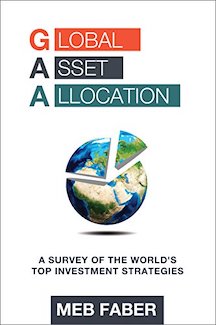 The book published in 2015 by Mebane Faber looks at different asset classes to invest money in and dives into the world’s top investment strategies. After having read lots of trading books I got this broad investing book just to read something different for a change. Though I haven’t moved from trading US stocks to a broader asset allocation, it’s good to keep eyes wide open and think about the bigger picture. I’ve been following Meb’s work for a while and besides being an author, he is a quant trader, angel investor and fund manager.
The book published in 2015 by Mebane Faber looks at different asset classes to invest money in and dives into the world’s top investment strategies. After having read lots of trading books I got this broad investing book just to read something different for a change. Though I haven’t moved from trading US stocks to a broader asset allocation, it’s good to keep eyes wide open and think about the bigger picture. I’ve been following Meb’s work for a while and besides being an author, he is a quant trader, angel investor and fund manager.
The book starts with a history of stocks, bonds and bills. He writes about inflation, shares some interesting charts about purchasing power of the US dollar during the past century and clarifies why keeping money under the mattress is a very bad idea. After showing real asset class drawdowns in the period of 1900 – 2014 he gets to the only free lunch in investing – diversification. The drawdown chart for US stocks and bonds looks horrific, to be honest. It just makes me think how luck and timing can have a big impact on the returns for “buy and hold” investors.
The benchmark portfolio 60/40
Meb goes over the most popular investing strategy of 60/40 (60% in S&P 500 stocks and 40% in 10-year US government bonds) that should reduce drawdowns and volatility with the expense of reducing returns a bit. Over a 100 years period this strategy has returned around 5% a year on average before inflation – not quite what an average investor would expect or hope for. The author shows how buying overvalued stocks have decreased returns even more over the following 10 years period. For example, in late ’90s the Shiller PE ratio (CAPE) was at a record breaking 45 for US stocks and the following 10+ years investors got really low returns compared to the average expectations. The time to buy undervalued stocks would be CAPE under its long-term average of 16,5. I have checked just now that today at the time of writing this, the CAPE ratio for US stocks is at 33.
Going global
A fun fact right here is that the world’s largest asset class is non-US bonds (2013). Another one to make a point is that about half of the global stock allocation should be in the US. The author is slowly getting to the point of his book that while many US investors have home country bias, the best diversification would be to invest with a global asset allocation. The same goes for investors in UK, Canada and Australia; therefore I can assume it actually goes for almost any investor in the world who has financial markets in the home country.
Strategy comparison
There are several portfolio management strategies described and compared in the book: Bridgewater’s Risk Parity and All Seasons, Harry Browne’s Permanent, the Global Market, the Endowment, Rob Arnott’s and Marc Faber’s portfolios and the Warren Buffett Asset Allocation Portfolio. Comparing all these different strategies invested in stocks, bonds and real assets (commodities, metals, REITs) brings up an interesting point – their returns over a longer time horizon do not differ much at all!
Summary
Wrapping up the topic, Meb writes about market timing and emotions. Besides retail investors, professionals often get the market timing wrong as well. He proves a great point about fees – even if one could predict the best asset allocation strategy ahead of time but paid average advisory and fund management fees for it, the returns were actually worse than the performance of the worst strategy. Fees are more important for a “buy and hold” portfolio than trying to figure out the best asset allocation!
Global Asset Allocation by Mebane Faber book link
Share this post